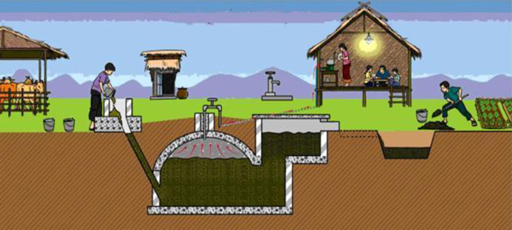8.6.1 Biogas production
In Study Session 5 you learned about the production of biogas from excreta by anaerobic digestion using the biogas latrine. The same technology can be used to treat food waste on its own or in combination with human excreta or animal manure.
Biogas recovery from organic waste (Figure 8.6) can be done at the kebele or household scale, where the biogas can be used for cooking and heating water. The sludge from the digester can be used as a fertiliser and soil improver. Another benefit of biogas production is the reduced use of fuel wood, which improves living conditions by reducing indoor air pollution. Additionally, biogas contributes to the reduction of greenhouse gases. The use of biogas as a cooking fuel will mainly benefit women because it will reduce their overall workload by providing energy for the household without requiring labour-intensive fuel collection.
Biogas production needs more equipment than composting, so it is more expensive to install. It also requires greater expertise than composting to operate and the equipment must be maintained. Small-scale biogas is well established in China and India, but this method is still relatively uncommon in Ethiopia (Rajendran et al., 2012).
To conclude this study session and provide an example of the various ways in which waste can be used, Box 8.1 describes the IGNIS programme, based in Addis Ababa. This programme included several pilot projects using many of the waste management options that you have been reading about.
Box 8.1 The IGNIS programme
The overall aim of IGNIS is to help people to generate income by recovering value from waste. This has involved the development and implementation of novel technologies and working to improve the social status and health of waste workers. Funding was provided by the German Federal Ministry of Education and Research, and the programme was run by a number of German and Ethiopian governmental agencies, academic institutions and non-governmental organisations (NGOs).
Some of the IGNIS projects include:
- Setting up a house-to-house collection of compostable waste and training people to make compost and to use it to grow vegetables.
- Collecting and composting waste from street markets and employing former street children and sex workers to collect the waste, as well as to make and sell the compost.
- Using the compost to fertilise and improve soil on deforested slopes around Addis Ababa which are prone to erosion. The land can then be planted with crops and brought back into use.
- Addressing the health issues (malnutrition and back problems) of the korales.
- Encouraging small-scale paper recycling factories.
- Supporting a women’s group in recycling charcoal dust and reconstituting it to make fuel briquettes.
- Installing pilot biogas plants that use food and kitchen waste to produce biogas for cooking.
- Making gloves from scraps of leather and textile wastes.
The IGNIS projects demonstrate that considering waste as a resource has many environmental, economic and social benefits. They also show how integrating different approaches to waste management can maximise the benefits.
8.6 Energy recovery

